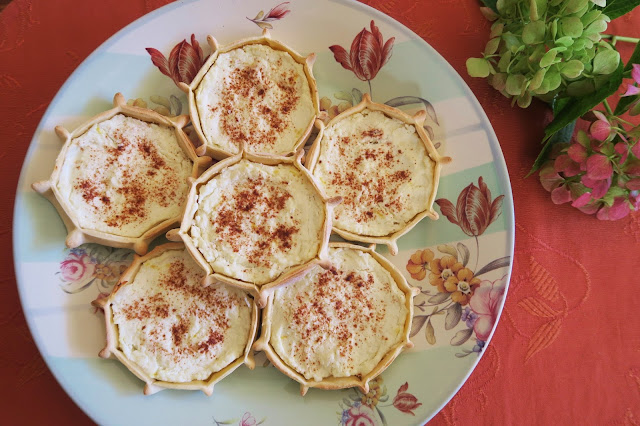Under the shade of my parents sugar plum tree I contemplate what the new year has in store and welcome her in with some freshly made apricot and plum jams and this delectable crostata. A new
look for this humble blog will also be launched today, with plans for further changes along the way. A task I have avoided for a long while due to lack of time. A fresh look for the beginning of a new year is what was needed and I hope that this format will make the site easier to navigate, but as mentioned with time there will be more noticeable changes for the better. Stay tuned! So what better way to celebrate than with a
slice of this plum jam crostata made
more special by the addition of some home-made sugar plum jam I made the other day.


My parent’s love of fruit trees provides us with an abundance
of fruit around the summer season. What
doesn't get eaten is preserved and used later in cakes, tarts as well as on
toast. I especially love a tart that uses home-made jams such as apricot, plum
or even quince and have a few variations in my recipe index. The recipe for the plum
jam used is a basic fail proof method that mamma makes. I have modified it slightly so that the skin of the
plum is not discarded, but processed within to balance the sweetness. I also like to use the kernels of the fruit
to help set the jam.
Marmellata di Prugne (Plum Jam)
Ingredients:
This quantity makes approximately enough jam for 8 jars (285
g each)
1 1/2 kg plums (washed and stone removed)
1 1/2 - 2 cups water
1 1/2 kg sugar
** Adding vin cotto to the plum jam is optional and gives more of a rich indulgent caramelised flavour to the jam. If you choose to do so, you will need 250 ml of vin cotto.
It's important to use well cleaned and sterilized jars when
storing preserved food. I thoroughly
wash, rinse and then place my jars and lids in a saucepan filled with water,
ensuring the jars are submerged and bring them to the boil. Continue boiling
for 10 minutes and keep in hot water until ready to use. Drain thoroughly and allow drying. Alternatively you can place your clean jars with
their lids upturned in a 110◦ C oven to sterilise them for about 30 minutes,
then turn the oven off and allow them to sit there until you are ready to fill
them. Also place a plate in the fridge
for testing the set of the jam.
Wash, halve and stone plums. Keep 10 of the stones aside,
loosely wrap them in a clean tea towel, and then bash them with a meat mallet.
Extract the kernels and tie securely in muslin with some kitchen string.
Slice plums roughly and place into a wide non-reactive saucepan
with sugar and water. Bury the muslin
bag among the fruit. Cook over a moderate heat stirring occasionally until the
mixture comes to a boil and skim the froth from the surface. Take the pot off the stove, remove the muslin
bag and with a hand held stick blender, process the fruit until the skin is
finely processed. Return the muslin bag
to the pot and place the pot back on the stove. **If you are adding the vin cotto, this is when to do so and stir through. Simmer for about 25 minutes
until setting stage is reached (around 105◦ C, if you have a candy thermometer), alternatively place a small drop of jam on a cold plate and if it doesn't slide off the plate it is set.
Remove from the heat and allow settling for 5 minutes. Remove
the muslin bag and pour the jam into warm sterilised jars and seal immediately.
Pasta Frolla (Short Crust Pastry)
Recipe 589 - from Pellegrino Artusi’s book Found Treasure - La Scienza
in Cucina e L'Arte di Mangiar Bene.
Artusi outlines three variations of this recipe, two of which
use lard. I have naturally opted for the recipe that uses butter.
Ingredients:
250 g plain flour, sifted
125 g butter, chilled and cubed
110 g caster sugar (I reduced the amount of sugar to 80 g due to the sweetness of
the jam)
zest of 1 organic lemon, freshly grated
1 whole egg, plus 1 yolk
Filling:
1 jar (285 g) plum jam
Cream the butter and sugar until the mixture is pale
yellow. Add the eggs and then fold
through the flour or if using modern appliances such as the Kitchen Aid, add all ingredients and pulse until combined. The secret is to not
over mix the soft pastry and to chill before rolling out.
Roll out two thirds of the chilled pastry to desired size and 3 mm in thickness. Place into a round tart tin of approximately 25 cm in diameter and 2 cm in depth. Use a knife to remove any overhanging dough and add it to the other piece which will be used for the lattice. Add the plum jam to the crostata and decorate with remaining pastry that has been rolled out and cut into strips to form a criss-cross pattern.
Bake in a moderate oven for 30 minutes until the crostata is golden brown. Allow to cool before removing from the tin carefully. Enjoy!








Comments
Post a Comment